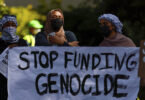Monitoring Desk
What’s new? Following Myanmar’s 1 February coup, newly organised militias have launched attacks in several parts of the country in response to regime killings of demonstrators. These lightly armed bands have inflicted significant casualties on the security forces, who have struck back with heavy weapons and bombardment of residential areas.
Why does it matter? The regime’s heavy-handed, indiscriminate retaliation has displaced tens of thousands of men, women and children. Local networks and humanitarian agencies are unable to adequately assist these people, due to security and access restrictions, including military arrests, confiscation of supplies, and killings of those trying to deliver aid.
What should be done? International actors – including in the UN Security Council – should press Myanmar’s regime to respect its legal obligations regarding the principles of proportionality and distinction, which its counter-insurgency strategy deliberately violates, and allow humanitarian access to all displaced people. Newly created militias must also refrain from abuses, particularly killing detainees.
I.
Overview
The Myanmar junta’s crackdown on protesters and the broader civilian population after the 1 February coup d’état has triggered violent resistance, including the formation of militias in parts of the country. Some such militias, armed with hunting rifles and other makeshift weapons, have used their numbers and knowledge of local terrain to inflict serious casualties on Myanmar’s military, known as the Tatmadaw. Security forces have responded with indiscriminate attacks on populated areas, using artillery, airstrikes and helicopter gunships. Tens of thousands of men, women and children have fled to the forest, with the regime blocking relief from reaching them. The Tatmadaw must meet its international obligations to respect the proportional use of force, distinguish between combatants and civilians, and allow unimpeded humanitarian access to those displaced. Outside actors have a responsibility, including in the UN Security Council, to ensure the regime faces consequences for international law violations. The militias, for their part, should not take the Tatmadaw’s grave abuses as an excuse to commit their own.
Citizens in many parts of Myanmar watched in dismay as the regime unleashed deadly violence against protesters and residents in major cities from late February. Determined to continue demonstrating against the coup, but also concerned that they faced the same threat from security forces, they began forming militias to defend themselves. Such groups have emerged in several areas of the country, responding to the security forces’ attacks with determined campaigns of armed resistance. They have been most effective in places with existing militias or ethnic armed groups, or strong traditions of hunting – where many men have access to weapons and know the terrain intimately. Many of these areas have seen no active conflict in years or decades, meaning the Tatmadaw has little established military and intelligence capability there.
With ground troops proving to be easy targets for ambushes, [the military] has unleashed long-range artillery, airstrikes and airborne assaults on populated areas.
Facing rising casualties, the military has responded with overwhelming force. With ground troops proving to be easy targets for ambushes, it has unleashed long-range artillery, airstrikes and airborne assaults on populated areas, such as the towns of Mindat (in Chin State) and Demoso (in Kayah State). The Tatmadaw is using its long-established “four cuts” counter-insurgency strategy in these areas, a cruel approach that deliberately targets civilians in an effort to deprive insurgents of food, funds, recruits and intelligence on troop movements (hence the four cuts). Attacks on populated areas are an integral part of this strategy, along with the looting of food stores and denial of relief supplies, in clear violation of international humanitarian law.
The fast emergence of these militias, and their capacity to evolve from loosely coordinated groups of local people into more structured, better armed and sustainably funded forces, likely marks a new phase of Myanmar’s decades-old civil war. Given the deep grievances in areas such as Chin and Kayah States – about the coup, but also over decades of neglect, ethnic discrimination and denial of rights – these militias are unlikely to simply disband or quickly fade away. They constitute new fronts for the Tatmadaw, which will probably keep blindly lashing out at civilians, as it has done repeatedly in the past when fighting many of the country’s ethnic armed groups. While these militias generally express support for the National Unity Government (NUG), the civilian body that has emerged to contest the junta’s claim to rule, they are not under its command or control.
In a context of national economic collapse and local penury, these new militias will have privileged access to resources and rent-seeking opportunities, such as other armed actors in the political economy of Myanmar’s conflict have long secured. Experience from other parts of the country shows that such groups can provide protection for residents but can also become a source of insecurity for them, as well as an economic burden.
Addressing these conflict dynamics and their impact on non-combatants is difficult without a return to more democratic and accountable civilian government, which the regime appears determined to prevent. Nevertheless, some steps can be taken now that would help meaningfully improve the situation:
The Tatmadaw must cease attacks on civilians in line with its international legal obligation to respect the principles of proportionality and distinction. The security forces must also stop impeding humanitarian access to displaced populations.
Outside actors should do what they can to ensure that the regime is held accountable for its violations of international law. UN Security Council members inclined to act could request that the UN secretary-general report in more detail on the extent of violence and any obstruction of aid in Myanmar, thus ensuring that the Council discusses these issues. All countries should stop the supply of weapons to the regime.
Humanitarian agencies and donors should use all available channels to press the regime for timely access to displaced people. Asian countries, which are likely to have the most influence, should also advocate for expeditious humanitarian aid as a matter of priority.
The militias likewise have an obligation to refrain from committing abuses, including killing of detainees and attacks on civilians and civilian property. All parts of the resistance must refrain in particular from targeting schools and medical facilities.
Even if it does not have command and control of these groups, the NUG should take steps to strengthen and further disseminate its military code of conduct, continue to publicly signal the priority it gives to this code and press all elements of the resistance to adhere to the provisions.
II.
Opposition to the Coup Takes a Revolutionary Turn
The military regime has responded to the anti-coup resistance with extreme violence, killing more than 870 people and detaining more than 6,000. The dead include protesters – many of whom were shot in the head – bystanders, random civilians shot in their houses and others tortured during interrogations. The crackdown has been effective in clearing the streets of the mass protests seen in the coup’s immediate aftermath, but it has provoked greater anger toward the regime. Mass protests have been replaced with flash mobs, which disperse before security forces can intervene, and strikes, boycotts and other forms of civil disobedience continue on a large scale.
The anti-regime resistance as a whole is diverse, organic and organised locally by professional groups (such as medical workers, engineers and teachers), pre-existing civil society networks, labour unions and others. Some of the members of parliament elected in the November 2020 polls, who were due to take their seats on the day of the coup, have come together to form a legislative body, the Committee Representing the Pyidaungsu Hluttaw (CRPH). It is composed mainly of members of Aung Sang Suu Kyi’s National League for Democracy (NLD) who are now in hiding, either in areas of the country controlled by ethnic armed groups or in exile. On 16 April, the CRPH established an executive body, the National Unity Government, with a diverse ethnic composition, especially at the deputy minister level.
The resistance has taken on an increasingly revolutionary character, with most dissidents no longer aiming for restoration of the status quo ante, but for the Tatmadaw’s disbandment and its replacement by a new armed force that is not dominated by the Burman ethnic majority. The CRPH/NUG has articulated its wish to create a “federal army”, under civilian control, with a more diverse ethnic composition and without the Tatmadaw’s institutional culture of violence against civilians. On 1 March, the CRPH went as far as to declare the regime a terrorist group, and the NUG did the same on 7 June.
This revolutionary agenda requires the Tatmadaw’s defeat or capitulation. The NUG first endorsed violent self-defence on 14 March and then announced the formation of its own armed wing, the People’s Defence Force (PDF), on 5 May. This step represents a decisive break with the policy of non-violence that the NLD adopted in its long years of opposition to military rule (1988-2011), which was a defining principle espoused by Aung San Suu Kyi herself. The regime responded on 8 May by declaring the CRPH, NUG and PDF to be “terrorist groups” under the Counter-terrorism Law.
The PDF is still a work in progress, with an aspirational structure on paper. Some young people, whom the NUG hopes to bring under its command, are being trained by ethnic fighters and some Tatmadaw deserters in areas controlled by ethnic armed groups. So far, three separate strands have emerged in the efforts at armed resistance:
First, the NUG attempted to convince existing ethnic armed organisations in Myanmar to join forces to fight the Tatmadaw under the banner of a new federal army. While several armed groups have expressed their support for the resistance and NUG, and in some cases provided sanctuary to fleeing dissidents, none has so far been willing to enter into a military alliance.
Secondly, the NUG announced the PDF, a tacit acknowledgement that it had been unable to form an alliance with ethnic armed groups and would instead form its own fighting force de novo. The challenges involved are enormous, however. The NUG does not control territory, and it is unlikely that ethnic armed groups would allow it to operate autonomously from places they control – for chain-of-command reasons, and because of likely regime retaliation; the Kachin Independence Organisation, for instance, has already said it will not do so. Although ethnic armed groups are providing military training to hundreds of young dissidents who have fled to areas under their control for sanctuary, these groups are not organised by the NUG and are not under its command, although they may share its objectives.
Thirdly, locally organised militias have been forming spontaneously in many places across Myanmar, in response to Tatmadaw violence. Groups such as the Chinland Defence Force (in Chin State), Kalay Civil Army (in Sagaing Region) and Karenni Nationalities Defence Force (in Kayah State) have clashed with the security forces – both repelling Tatmadaw attacks and going on the offensive to take control of towns or rural areas. The NUG’s announcement of the PDF was intended in part to unify these various local groups under its umbrella. But while many of them are supportive of the NUG and some have pledged allegiance to it, they are not under its command. Some of the largest groups have had no contact at all with the NUG (see Section III.C below).
In addition to organised militias, networks of civilians have responded to the regime’s use of brutal violence with asymmetric attacks on government and other targets in Yangon, Mandalay and elsewhere – including with improvised explosive devices, arson and killings of administrative officials and suspected regime informants. These networks include some people who have been trained in ethnic armed group areas and have subsequently returned to the cities. Since early April, there have been hundreds of explosions in various parts of the country, with the largest concentration in Yangon.
Bomb and arson attacks have struck educational institutions, local administration offices, the homes of regime-appointed officials, police and military personnel and installations, and banks. Schools have been particularly hard-hit, with dozens across the country targeted in an apparent effort to deter parents from registering their children ahead of the new school year starting 1 June, which anti-coup forces have called upon the population to boycott. On 26 May, the NUG issued a set of ethical rules for resistance forces, inter alia prohibiting attacks on schools, medical facilities and other civilian targets. Since then, attacks on schools have declined but not stopped.
III.
The New Armed Resistance
As the regime began to use increasingly deadly violence against protesters and the broader civilian population from late February, city residents began to take measures to protect themselves from the security forces and deter their night-time raids. They barricaded access roads, appointed nightwatchmen to give early warning of the security forces’ incursions and formed defence groups made up of mostly young men and women armed with makeshift weapons and shields.
As the military deployed front-line troops to force residents of Yangon, Mandalay and other towns to remove these roadblocks over the month of March, many members of these improvised defence forces either went underground or fled to ethnic armed group-controlled areas seeking weapons and training. Some of these underground cells, and networks of people who have now returned to the cities after receiving limited training, have begun carrying out opportunistic attacks, including bombings.
In other parts of the country, the situation has evolved differently. With the regime focused on quashing dissent in the main cities, people in many provincial towns and rural areas were able to continue demonstrating without facing violent crackdowns. As they saw the death toll mounting in other areas, however, some of these communities began organising themselves to resist the security forces. When protesters began to be arrested or shot in their areas, they were ready to retaliate.
A.
The Battle for Mindat
On 4 April, resistance cells from all nine townships of Chin State came together to form the Chinland Defence Force (CDF). Located in the country’s north west, bordering India, the mountainous state is Myanmar’s poorest. On 24 April, CDF members in the southern town of Mindat clashed with the security forces for the first time, after officers refused to release seven people, three men and four women, detained for putting up anti-regime stickers in town. Residents said the detentions violated an informal agreement between security forces and the townspeople that troops would take no action against protesters as long as they remained peaceful. Protesters had gathered in the town centre to demand the detainees’ release, and when a police officer fired into the crowd, the defence force retaliated, reportedly shooting dead three members of the security forces.
The situation escalated rapidly from there. The army attempted to bring in troops by road to reinforce the overwhelmed local battalion in Mindat. On 26 and 27 April, CDF fighters ambushed military convoys on the roads leading to the town, reportedly killing more than 30 troops, destroying army trucks and looting weapons. Although the CDF fighters were only lightly armed with traditional flintlock rifles, they were experienced at using these for hunting, had intimate knowledge of the terrain and outnumbered their targets – amassing hundreds of fighters to strike the convoys.
Seemingly taken aback by the level of resistance it was facing, on 27 April the military initially tried to negotiate with Mindat town elders, seeking an agreement that attacks on troops would end in return for the release of detained demonstrators; the truce broke down after a few hours when the security forces failed to release all the seven detainees. Further negotiations were held on 1 May and 9 May, aiming to reach agreement on the withdrawal of fighters from both sides from the downtown area, the withdrawal of troops from outside medical facilities and banks, permission for CDF fighters to return home with no retaliation, and the release of five remaining detainees. Discussions broke down on 12 May, with the military still refusing to release one of the detainees.
The military was able, however, to negotiate safe passage for a convoy of troops through Mindat, on 7 May, in order to resupply its bases in Paletwa township further south. Paletwa had been the site of some of the most intense conflict between government forces and the Arakan Army, an ethnic Rakhine rebel force, from January 2019 until the informal ceasefire in November 2020. Chin people were caught in the crossfire of that conflict, and were at times targeted by the Arakan Army, so the CDF may have had some interest in allowing the convoy to proceed.
After negotiations collapsed on 12 May, CDF fighters attacked soldiers posted outside a bank in the downtown area. The following day, the regime declared martial law in Mindat and began shelling the town. On 13 and 14 May, the military sent two convoys of reinforcements, which were again ambushed by the CDF. Tatmadaw troops fled, and CDF fighters seized large quantities of weapons from the trucks before destroying nine of them.
With the CDF controlling all roads into Mindat, on 15 May the military launched an airborne offensive, first shelling the town, then flying in several hundred troops by helicopter to seize control. The CDF retreated into the surrounding hills, and most townspeople also fled; thousands remain in makeshift settlements in the forest. The military now controls the town, but clashes continue in the surrounding areas, including Tatmadaw attacks in areas that civilians have fled to. The CDF told Crisis Group it is regrouping and preparing for new attacks, but in order to protect civilians, it will no longer base itself in urban areas.
The townspeople remained determined to resist the coup and defend themselves from military violence.
While negotiations in Mindat initially broke down over specific demands, no broader compromise or de-escalation was ever really likely while the group controlled the town. The military was never going to allow the CDF to take de facto control of Mindat, and the townspeople remained determined to resist the coup and defend themselves from military violence. It was only once the Tatmadaw had taken control of the town and most of the population had fled that the dynamic shifted. At this point, on 20 June, town elders brokered a fourteen-day truce between the CDF and the military in the hope that the pause would allow aid to reach displaced people and discussions about a longer ceasefire to take place.
The Tatmadaw’s willingness to negotiate with the CDF (and with the Kayah resistance group, see below) is striking, and very different from its approach in the central parts of the country, where troops have issued ultimatums, but shown no inclination to bargain with protesters. Whether from necessity, due to the strength of the group, or because Mindat is a remote town that the military considers less critical to its political objectives, its treatment of the CDF is closer to the way it engages ethnic armed groups – to be fought, defeated if possible, but also managed as a threat – than a group of violent protesters.
B.
Clashes in Other Areas
Mindat is one of many places across Myanmar where residents are organising armed resistance to the security forces following the coup. Locally organised militias have battled the security forces in other parts of Chin State, Kayah State and Sagaing, Magway and Mandalay Regions.
The first major clashes of this kind took place in Tamu township in Sagaing Region on the Indian border. After security forces shot dead a protester on 25 March, townspeople formed the Tamu Security Group (TSG) and began stockpiling hunting rifles, buying grenades on the black market and making improvised explosive devices. On 1 April, a police officer who had defected to the TSG led a grenade attack on a police outpost in Tamu – there have been numerous cases of police and soldiers defecting or deserting since the coup, but overall the numbers are very small. Five police officers were killed, as well as the renegade officer. Three days later, a TSG member threw a grenade into a truck carrying troops, killing four. Three more soldiers were killed with grenades on 27 April, along with a military defector who was patrolling with the TSG. By early May, the TSG had been able to purchase more modern light infantry weapons, including M-16 and AK-47 assault rifles.
According to a TSG spokesperson, on 11 and 12 May, the group launched a series of attacks on army outposts in villages around Tamu town. These outposts were newly established, as part of military efforts to prevent TSG members from assembling and moving freely. The spokesperson told Crisis Group that the troops were abusive to villagers, demanding food and protection money. In total, it said its fighters killed fifteen soldiers over these two days. Unfamiliar with these areas, where there had previously been no troops, the military enlisted the help of a militia made up of ethnic Meitei fighters from across the border in the Indian state of Manipur. This militia was allegedly involved in illicit cross-border business in the area and is known to harass local people. The TSG claimed that in addition to the military casualties, it killed four Meitei militiamen. The situation remains tense, and the group says it stands ready to launch further attacks on the military.
Major clashes have also erupted in Kayah State, bordering Thailand, in south-eastern Myanmar. According to those involved in the anti-regime violence, fighting started in the town of Demoso, with army demands that protesters remove roadblocks they had erected. When they refused to, on 20 May the army attempted to do so by force, prompting armed protesters to strike back the following day. Initially organised as local militias armed with hunting rifles, they subsequently joined forces with the Karenni Army and fighters from other longstanding ethnic armed groups operating in Kayah State – some with the endorsement of their groups, others on an individual basis – to form the Karenni Nationalities Defence Force (KNDF). The group seized three police outposts in Demoso on 21 May, and on 23 May it overran a security post in Moebye in southern Shan State, on the Kayah State border, killing some twenty police officers and soldiers and capturing four.
The KNDF said it has killed nearly 200 members of the security forces since 21 May, including unverified claims of more than 80 on 31 May alone. In retaliation, the military deployed artillery barrages, airstrikes and helicopter gunships against Demoso town, where KNDF fighters were positioned, causing several civilian casualties. More than 100,000 civilians have reportedly been displaced since 21 May as a result of the fighting. The KNDF has also targeted alleged informants and likely executed several captured members of the security forces.
After the first deadly clashes on 21 May, the military had attempted to negotiate with the militia, but the group rejected its overtures as lacking credibility; subsequently, the military switched to using overwhelming force. The huge impact on civilians forced the resistance fighters to reconsider their stance, and several leaders of the KNDF – representing both the new defence forces and some of the existing armed groups involved – met with the Tatmadaw regional commander on 15 June for talks facilitated by local church leaders. The two sides agreed to a temporary ceasefire which the KNDF hoped would make it easier for relief supplies to reach displaced people. The ceasefire is very fragile, however – the Tatmadaw gave no specific commitment on aid delivery, and some KNDF leaders are sceptical of the wisdom of negotiating with the military.
C.
Why Has Armed Resistance Taken Hold in These Areas?
The emergence of armed resistance in north-western Myanmar and Kayah State represents a new phenomenon that is different in important ways from Myanmar’s decades-old ethnic armed conflicts. Prior to the coup, these parts of the country had not experienced significant fighting for many years. Several local factors have facilitated the emergence of armed resistance.
First, there is a strong tradition of hunting in these areas, which means that many households have locally made flintlock rifles or shotguns, and many men know how to use them and have detailed knowledge of the local terrain. Gunpowder, needed for flintlock rifles, is widely available in these parts, and can also be used to make improvised explosive devices.
Secondly, these areas lie in the path of illicit trade in light infantry weapons, including assault rifles, ammunition and hand grenades, as well as rifle-launched and rocket-propelled grenades. North-western Myanmar is a conduit for weapons destined for insurgent groups in north-eastern India, which are transported through Shan and Kachin States and across Myanmar, before making their way to the border. With money and the right contacts, it is possible to purchase these arms in the north west, as the Tamu Security Group says it has done. On 24 May, security forces also claimed to have arrested a group of men in Mandalay who were attempting to move a large quantity of arms to Tamu, subsequently seizing 21 assault rifles, 133 hand grenades and other weapons, as well as detonators and ammunition. Similarly, in Kayah State it is possible to obtain weapons from the many armed groups and militia operating in the state and in other parts of south-eastern Myanmar, or via the longstanding arms trade that supplies those groups.
Thirdly, although there has been no major armed conflict in these areas in many years, an ecosystem of non-state armed activity persists: Tatmadaw-aligned militias in some places; residents who have been insurgent fighters in the past; social and ethnic links with armed groups in other parts of Myanmar or across the border in India; and ethnic armed groups (including in other parts of the country) willing to give training and even provide military support. For example, both the CDF and TSG told Crisis Group that some of their members had received military instruction from ethnic armed organisations, either in the past or since the coup. In Kayah State, ethnic armed groups are fighting alongside the newly created militias and have now even formed a joint structure (see III.B). A militia in Katha, Sagaing Region, also received military backup from the Kachin Independence Organisation fighters when it clashed with the Tatmadaw on 30 May. In addition, police officers have defected to both the Mindat and Tamu militias, providing security expertise and intelligence.
The civilian National Unity Government will struggle to achieve its stated goal of bringing these militias under a single command. The NUG has said that it seeks to build up an armed wing and that it will provide material support to militias and perhaps a military governance structure. But the NUG’s capacity to issue orders to such forces is limited, its resources are constrained and most of its leaders are now in exile. Moreover, the diverse nature of the militias, and communications problems present significant challenges to putting in place a unified chain of command.
Indeed, while these militias mostly express support for the NUG, some of the largest have had no contact with the parallel government and others do not envisage coming under its command. Those in ethnic minority areas are much more likely to form alliances or come under the authority of ethnic armed groups, as the Kayah militia has already done, and as the Kachin Independence Organisation has made clear any militia in Kachin State would have to do. As described, ethnic armed groups for their part have declined to form a military alliance with the NUG.
IV.
Implications
The rise of new militias in many different locations has created a much more complex conflict landscape for the Tatmadaw. It now faces a large number of geographically dispersed foes, including in many areas where it has not fought for years and lacks established ground forces, intelligence and knowledge of the terrain. Confronting these groups while also dealing with escalated fighting with ethnic armed groups in Kachin, Shan and Kayin States, and continuing a major deployment of troops to the main cities to suppress dissent, will likely stretch the regime’s forces. Its troops’ morale may take a hit.
This situation is, however, not unprecedented for the Tatmadaw, which has been fighting a constantly evolving set of insurgencies since Myanmar’s independence in 1948. Until the late 1980s, much of the country’s ethnic regions were in rebellion, and the Tatmadaw was therefore fighting simultaneously on many different fronts; and in the last few years, it has been battling the new Arakan Army insurrection in Rakhine State, an area that had not seen significant fighting for decades. Counter-insurgency campaigns have been the Tatmadaw’s stock in trade. It has a brutal approach to them that it has employed for decades. Known as the “four cuts” strategy, it deliberately targets civilians as an essential support base for insurgency, aiming to deny rebels four essentials: food, funds, intelligence and recruits. Faced with armed insurrection, the Tatmadaw can be expected to unleash its military might against civilians, as it has already done in Mindat and Demoso. The human cost will be enormous – particularly for women, children and the elderly, who face the greatest hardships from violence and displacement.
Getting the Tatmadaw to cease attacks on civilians will be no small challenge. The Myanmar military clearly has an international legal obligation to respect the principles of proportionality and distinction – that is, to avoid attacks that would cause disproportionate harm to civilians and civilian property, and to distinguish between combatants and civilians. But in the past, the generals have rarely taken such obligations into account, been careful to avoid civilian harm or heeded outside concerns and criticism. Moreover, while Western sanctions have been necessary to signal the unacceptability of the coup and crackdown, they are unlikely to change the Tatmadaw’s calculations about its use of force.
For their part, the militias should not take the Tatmadaw’s grave violations as licence to commit their own and must avoid killings of detainees, which have been documented on several occasions, as well as attacks on civilian targets including educational and medical facilities. The NUG, even if it does not have command and control of these groups, should continue strengthening its military code of conduct, ensure that this code is widely disseminated, carry on publicly signalling the priority it gives to the document and use its influence to press all resistance elements to adhere to the provisions.
Humanitarian support is urgently needed. Local networks and humanitarian organisations face security challenges in gaining access to conflict areas and displaced populations, compounded by the fact that some of the affected areas have not seen conflict or needs on this scale before, which means that agencies have no existing operations there. For example, domestic networks that have been trying to deliver support to people displaced from Mindat town report that the security forces are blocking travel to these areas, confiscating relief supplies and arresting – and in at least two cases, killing – those transporting them. There are similar challenges in other areas. Primary responsibility rests with the security forces, who must end their blockades of displaced populations, and must not impede humanitarian access to them. For their part, humanitarian agencies should use all available channels to the regime to press for urgent access to displaced people. Asian countries, which are likely to have the most influence, should also advocate for humanitarian aid as a matter of priority.
International actors should do what they can to stop the regime from continuing its egregious violations of international law with impunity and its blockage of aid flows. While the UN Security Council is unlikely to take decisive action over Myanmar, China and Russia did sign on to a March statement that referenced limiting violence and humanitarian access. Western and other Council members could push for the UN secretary-general to report in detail on these points so that they are at least raised in the Council. It might even be possible to reach greater consensus on humanitarian access, for example, than on a return to democracy. Moreover, an 18 June UN General Assembly Resolution showed deep international disquiet at events in Myanmar. Operationalising this resolution – and its calls for de-escalating violence and preventing an influx of weapons into Myanmar – will be difficult given that Myanmar’s allies and some key arms suppliers abstained. But the 119 states that voted in favour – including a number of arms suppliers to Myanmar – now have further moral obligation to do so.
There may be longer-term consequences of these new insurrections. The new militias are evolving from loosely organised networks into more structured forces as they acquire more effective weapons, develop chains of command and seek sources of revenue beyond the ad hoc community donations that have so far sustained them. The grievances driving resistance in many of these areas, while stemming from the coup and subsequent regime violence, also run deeper: these are historically neglected ethnic minority communities with the same desire for greater autonomy and rights as in other areas with established ethnic armed groups. While they may hope for revolutionary changes at the national level, they also have specific ethno-nationalist demands.
Driven by these strong grievances, and with the privileged access to resources and economic rents that armed actors typically enjoy, these militias are unlikely to disband. On the contrary, the coming period of national economic collapse, widespread poverty and deprivation will give them greater incentive to secure sources of revenue, either directly from locals or at their expense. These factors point to the likely emergence of new, sustained armed groups in these areas, following dynamics witnessed many times over the decades of insurgency in various parts of Myanmar. Breaking the cycle of repression, resistance and predation requires a political solution to the underlying drivers of conflict and a reformed political economy that produces more equitable outcomes. The coup has fatally damaged the prospects for both.
V.
Conclusion
Myanmar’s 1 February coup d’état has unleashed not only demonstrations and civil disobedience, but also violent resistance in many areas. In some parts of the country, newly organised militias have launched attacks in response to killings of demonstrators by the security forces. These militias – armed initially with hunting rifles and other makeshift weapons, but now increasingly obtaining more modern armaments – have inflicted significant casualties on the Tatmadaw and police, who have responded with heavy weapons and airstrikes on civilian areas, displacing tens of thousands of men, women and children. Local support networks and humanitarian agencies are unable to adequately assist these people, due to security and access restrictions, including Tatmadaw arrests and killings of those trying to deliver aid, and confiscation of supplies.
In the longer term, the emergence of these militias may represent a new dimension of armed conflict in Myanmar. Those that are successful in developing more durable structures and funding sources are unlikely to disband. They may become part of the next generational cycle of armed resistance to the Tatmadaw – and the latest participants in Myanmar’s enduring conflict economy.
Appendix A: Map of Myanmar

Appendix B: Map Showing Locations Mentioned in the Report

Appendix C: List of Acronyms
CDF Chinland Defence Force
CRPH Committee Representing Pyidaungsu Hluttaw (parallel legislature formed by MPs-elect after the coup)
KNDF Karenni Nationalities Defence Force (a group formed from an alliance between the KPDF and members of ethnic armed groups in Kayah State, including the Karenni National Progressive Party and its armed wing, the Karenni Army)
KPDF Karenni People’s Defence Force (this evolved into the KNDF, see above)
NUG National Unity Government (the parallel civilian administration formed by the CRPH)
PDF People’s Defence Force (the armed wing of the NUG, currently still being developed; this is separate from the multiple locally organised civilian militias, such as the KPDF, which often include “people’s defence force” in their names)
TSG Tamu Security Group (also known as the Tamu People’s Defence Force)
Courtesy: (crisisgroup)






